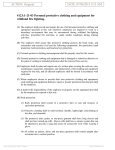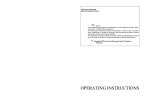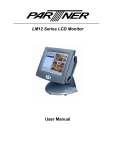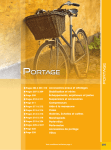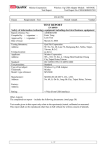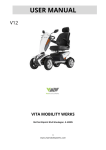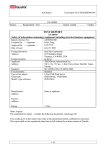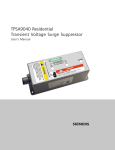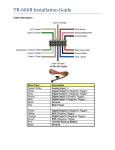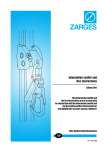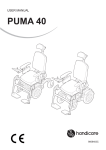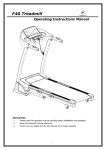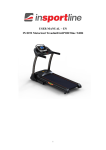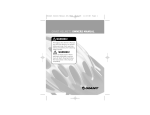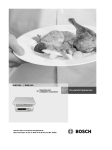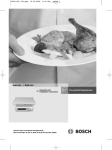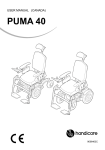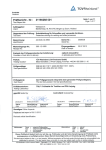Download View - Register of Ohio
Transcript
ACTION: Revised DATE: 07/16/2015 1:39 PM 4123:1-21-03 Personal protective clothing and equipment for wildland fire fighting. (A) The employer shall provide and require the use of all personal protective clothing and equipment specified in this rule whenever employees are required to work in a hazardous environment that may be encountered during wildland fire-fighting activities, prescribed fire activities, or under similar conditions during training activities. (B) The employer shall assure that protective clothing protects the head, body, and extremities and consists of at least the following components: foot protection, hand protection, body protection, and head and eye protection. (C) Personal protective clothing and equipment shall be properly sized for the wearer. (D) Personal protective clothing and equipment that is damaged or otherwise defective to the point of voiding its intended protection shall be removed from service. (E) Employers shall develop and require use of a written plan covering the safe use, care, maintenance, inspection, limitations, and replacement of the clothing and equipment required by this rule, and all affected employees shall be trained in accordance with such plan. (F) Where employees choose to provide their own protective clothing and equipment, such clothing and equipment shall give equal or greater protection than that provided by the employer. (G) It shall be the responsibility of the employee to properly use the equipment provided by the employer as required in this rule. (H) Body protection. (1) Body protection shall consist of a protective shirt or coat and trousers, or equivalent protection. (2) Protective clothing shall be melt-resistant, durable, lightweight, nonirritating to the skin, and cleanable. (3) The protective shirt, jacket, or one-piece garment shall have long sleeves and shall not have turned-up cuffs. Sleeve cuffs shall have a closure system that can be adjusted to provide a snug and secure fit around the wrist while wearing a glove. (4) All collars on jackets, shirts, and one-piece garments shall remain upright after extension into a vertical position. RB p(153237) pa(281220) d(612663) ra(468813) print date: 07/16/2015 8:00 PM (5) Any pass-through openings in garments shall have a means of fastening them in a closed position. (6) All pockets that open to the exterior of garments, other than front waist pockets, shall have a cover or closure system. (7) All garments that encompass the neck area shall have a closure system at the neckline. (8) All closure systems shall not come into contact with the body. Hardware of any garment shall not come into direct contact with the wearer's body. (9) Protective clothing for wildland fire fighting shall be repaired in accordance with manufacturer's requirements. If protective clothing cannot be repaired without decreasing the protective qualities, it shall be replaced. (10) Protective clothing shall be designed to give minimum interference to physical movement and to the use of fire-fighting tools. (11) Where wildland fire fighting protective clothing is required, a fire shelter shall be included. (12) Performance requirements. (a) Protective garments shall be capable of withstanding all tests specified in NFPA 1977, "Protective Clothing and Equipment for Wildland Fire Fighting, 2005 2011 Edition,." with the following minimum results: (a) Flame resistance. (i) Clothing directly exposed to fire environment and subject to flame impingement shall meet the following minimum flame resistance requirements. (a) 2.0 seconds afterflame; (b) 4.0 inches average char length; (c) Shall not melt or drip. (ii) Small clothing specimens such as labels, hanger loops, emblems, and patches that are not large enough to meet the specimen test size shall meet the following minimum flame resistant requirements: (a) Shall not be totally consumed; (b) 2.0 seconds afterflame; (c) Shall not melt or drip. (b) Radiant protective performance. Clothing shall have an average radiant protective performance (rpp) value of not less than seven. (c) Heat and thermal shrinkage. Clothing shall not shrink more than ten per cent in any direction and shall not melt, drip separate, or ignite. In addition, garment textile fabrics shall not char. (d) Total heat loss. Garment composites shall have a total heat loss of not less than 450 W/m². (e) Thread heat resistance. All sewing thread used in the construction of garments shall not ignite, melt, or char. (f) Tear resistance test. Garment composites shall have a tear strength of not less than five lbf (twenty-two N). (g) Cleaning shrinkage resistance test. Clothing shall not shrink more than five per cent in any direction. (h) Seam breaking strength. (i) Woven garment seam assemblies, containing at least one woven material, shall demonstrate a sewn seam strength equal to or greater than seventy lbf (three hundred fifteen N) for major seams and fifty lbf (two hundred twenty-five N) for minor seams. (ii) All knit garment seam assemblies shall demonstrate a sewn seam strength equal to or greater than forty lbf (one hundred eighty N). (iii) Where fabric strength is less than the required seam strength, providing that the fabric fails without failure of the seam below the applicable forces, the seam breaking strength shall be considered acceptable. (i) Garment product label test. Garment product labels shall be tested for legibility and shall not be torn, shall remain in place, and shall be legible to the unaided eye. (j) Retroreflectivity and flourescence test. Where trim is used on garments, trim shall be tested for retroreflectivity and fluorescence and shall have a coefficient of retroreflection of not less than one hundred cd/fc/ft/ sq. (b)(k) The thermal and moisture barriers required for structural fire fighting in paragraph (J) of rule 4123:1-21-02 of the Administrative Code are not required for wildland fire fighting. (13) Each garment shall have a product label(s) permanently and conspicuously attached. At least the following information shall be on the product label: (a) "This wildland fire-fighting protective garment meets the garment requirements of NFPA 1977, Standard on Protective Clothing and Equipment for Wildland Fire Fighting, 2005 2011 Edition. Do not remove this label." (b) Manufacturer's name, identification, or designation; (c) Manufacturer's address; (d) Country of manufacture; (e) Manufacturer's garment identification number, lot number, or serial number; (f) Month and year of manufacture (not coded); (g) Model or style name, number, or design; (h) Size; (i) Garment materials and percent content; (j) Certification organization's label, symbol, ;or identifying mark; (k) Cleaning precautions. (14) The garment manufacturer shall provide a user manual that describes the care, use, inspection, maintenance, limitations, and replacement of protective clothing. (I) Foot protection. (1) Foot protection shall be achieved by protective workstyle boots worn in combination with protective trousers that meet the requirements of paragraph (H) of this rule. (2) Footwear shall consist of a sole with heel, upper, insole, and shank. The quarter section of the boot shall be designed to provide an adjustable, snug fit for support around the ankle and lower leg. (3) Heel breast shall not be less than one-half inch (thirteen mm). Heel breasting angle shall not be less than ninety degrees nor more than one hundred thirty-five degrees relative to the sole (see figure 1). (4) Protective footwear shall extend at least eight inches above the bottom of the heel and shall be equipped with skid-resistant outer soles. (5) All thread used to manufacture footwear shall be made of inherently flameresistant fiber. (6) Protective footwear meeting the requirements of paragraph (K) of rule 4123:121-02 of the Administrative Code shall be considered to be in compliance with this rule. (7) Performance requirements. Footwear shall be capable of withstanding all tests specified in NFPA 1977, "Protective Clothing and Equipment for Wildland Fire Fighting, 2005 2011 Edition,." with the following minimum results: (a) Flame resistance. Footwear, excluding laces, shall not have an afterflame greater than two seconds, and shall not ignite, melt, or char. (b) Heat and thermal shrinkage resistance. Footwear, excluding laces, shall not melt, shall have no delamination of any part of the footwear, and shall have all accessories remain functional. (c) Cut resistance. Footwear shall have a distance of blade travel greater than one inch (twenty five mm). (d) Puncture resistance. Footwear shall have a puncture force of not less than thirteen lbf (fifty-nine N). (e) Conductive heat resistance. The footwear inside sole surface temperature shall not exceed one hundred eleven degrees Fahrenheit (forty-four degrees Celsius). (f) Thread heat resistance. All sewing thread used in the construction of footwear shall not melt, drip, or ignite. (g) Corrosion resistance. Metals inherently resistant to corrosion shall show no more than light surface-type corrosion or oxidation. Ferrous metals shall show no corrosion of the base hardware. Hardware shall remain functional. (h) Abrasion resistance. Footwear sole and heel composites, excluding the sole and heel composites of caulked boots, shall have an abrasion resistance rating of not less than one hundred NBS index. (i) Slip resistance. Footwear sole composites shall have a minimum static coefficient of friction value of 0.5. (j) Eyelet and stud post attachment test. Eyelets and stud hooks shall have a minimum detachment strength of sixtysix lbf (two hundred ninety-four N). (k) Label durability and legibility test. Footwear labels shall not be torn, shall remain in place, and shall be legible to the unaided eye. (8) Labeling. Each footwear pair shall have a product label(s) permanently and conspicuously attached to each boot half pair. At least the following information shall be on the product label: (a) "This wildland fire-fighting protective footwear meets the footwear requirements of NFPA 1977, Standard on Protective Clothing and Equipment for Wildland Fire Fighting, 2005 2011 Edition. Do not remove this label." (b) Manufacturer's name, identification, or designation; (c) Manufacturer's address; (d) Country of manufacture; (e) Manufacturer's footwear identification number, lot number, or serial number; (f) Month and year of manufacture (not coded); (g) Model, style name, number, or design; (h) Footwear size and width; (i) Certification organization's label, symbol, or identifying mark; (j) Cleaning precautions. (9) The footwear manufacturer shall provide a user information guide that describes the care, use, inspection, maintenance, limitations, and replacement criteria. (J) Head protection. (1) Wildland fire fighters' helmets shall consist of a shell with brim or peak, an energy-absorbing system, suspension system with sweatband, chin strap, nape device, goggle clips, and retroreflective markings. Provisions shall be made for ventilation between the head and the helmet shell. (2) The helmet shall be generally dome shaped. The area under the peak or the front of the brim shall be permitted to be covered only with a non-conducting, nonflammable, anti-glare material. Clips for headlamps or goggles shall be permanently attached with at least one clip at the rear of the helmet, and one clip on each side of the helmet. (3) Helmets shall meet as a minimum the requirements for type 1, class G helmets as specified in ANSI Z89.1, 2014 Edition, "Protective Headware for Industrial Workers." “Industrial Head Protection.” The complete helmet, with energyabsorbing system, suspension system with sweatband, chin strap, nape device, goggle clips, and retroreflective markings shall not weigh more then than twenty oz (five hundred seventy g). (4) Chin straps shall be provided that attach to the helmet shell. Both chin and nape straps shall not be less than one-half inch (thirteen mm) in width. (5) All helmets shall have retroreflective markings on the exterior of the shell. A minimum of four inches² of retroreflective markings shall be visible when the helmet is viewed from the sides, front, and rear. The retroreflective markings shall be placed above the goggle or headlamp clips so as not to be obscured by any clip, or the strap retained by the clips. (6) There shall be no openings penetrating the shell except those provided by the manufacturer for mounting energy-absorbing systems, retention systems, and accessories. (7) The addition of helmet accessories shall not interfere with the function of the helmet or its component parts and shall not degrade the helmet's performance below the requirements of this rule. (8) Performance requirements. Helmets shall be capable of withstanding all tests specified in NFPA 1977, "Protective Clothing and Equipment for Wildland Fire Fighting, 2005 2011 Edition." (a) Winter liners. All winter liners, if used, shall be fabricated of materials that will comply with paragraph (H)(12) of this rule. (b) Impact-resistance. Five specimen helmets shall be tested and shall have no specimen transmit an average force of more than eight hundred fifty blf. (three thousand seven hundred eighty N).No individual specimen shall transmit a force of more than one thousand lbf (four thousand four hundred fifty N). (c) Penetration-resistance. The penetration striker shall not make contact with the headform as indicated by the contact indicator. (d) Helmet antiglare flammability. Helmets, and any antiglare material provided, shall not show any visible afterflame time greater than five seconds. (e) Heat and thermal shrinkage. Helmets shall not have any deformation of the brim or peak exceed twentyfive per cent of its length. (f) Suspension system retention. The force required to separate any individual attachment point of the suspension assembly from the helmet shell and each adjusting mechanism of the suspension system assembly, shall not be less than five lbf (twentytwo N). There shall not be any failure of any adjusting mechanism to function properly. (g) Retroreflectivity. Helmet trim shall have a coefficient of retroreflection of not less than 100cd/lux/m² (100cd/fc/ft²). (h) Chin strap retention. Helmet chin strap shall have no failure of any mechanism to function properly, shall not exhibit any breakage, and shall not stretch or slip more than one and one-half inches. (i) ) Goggle/headlamp clip attachment. Helmet goggle or headlamp clips shall not release from the shell and shall not deflect more than one-fourth inch from their original position. (j) Thread heat resistance. All sewing thread utilized in the construction of the helmet, excluding that used on the crown straps, shall not ignite, melt, or char. (k) Label durability. Helmet labels shall not be torn, shall remain in place, and shall be legible to the unaided eye. (9) Helmets shall have a product label permanently and conspicuously attached. At least the following information shall be on the product label(s): (a) "This wildland firefighting protective helmet meets the helmet requirements of NFPA 1977, Standard on Protective Clothing and Equipment for Wildland Fire Fighting, 2005 2011 Edition. Do not remove this label." (b) Manufacturer's name, identification, or designation; (c) Country of manufacture; (d) Manufacturer's helmet identification, lot, or serial number; (e) Month and year of manufacture (not coded); (f) Model or style name, number, or design; (g) Helmet size or size range; (h) Nominal weight of helmet; (i) Certification organization's label, symbol, or identifying mark; (j) Cleaning precautions. (10) The wildland helmet manufacturer shall provide a user information guide that describes the care, use, inspection, maintenance, limitations, and replacement criteria. (11) Eye protection shall be provided by goggles. Goggles may be attached to the helmet within the constraints of paragraphs (J)(6) and (J)(7) of this rule. (K) Hand protection. (1) Gloves shall be designed such that they closely conform to the wrist or are adjustable at the wrist and shall extend a minimum on one inch (twenty-five mm) past the wrist crease. (2) All thread used to manufacture gloves shall be made of inherently flame-resistant fiber. (3) Gloves shall be maintained and repaired in accordance with the manufacturer's requirements. If gloves cannot be repaired properly without decreasing the protective qualities required by this rule, they shall be replaced with gloves that meet the requirements of paragraph (K) of this rule. (4) Performance requirements. Gloves shall be capable of withstanding all tests specified in NFPA 1977, Protective Clothing and Equipment for Wildland Fire Fighting, 2005 2011 Edition, with the following minimum results:. (a) Heat resistance test. Gloves shall not separate, melt, ignite, or drip, and shall not shrink more than ten per cent in either direction and shall be flexible. (b) Flame resistance test. (i) Gloves shall not melt or drip. (ii) Gloves shall not have any afterflame of more than two seconds. (iii) Gloves shall not have any char length in excess of four inches. (iv) The consumed materials shall not exceed fifty per cent of the specimen's original weight. (c) Conductive heat resistance. Gloves shall have a second-degree burn time of not less than seven seconds, and the pain time shall not be less than four seconds. (d) Thermal protective performance. Gloves shall have an average tpp of not less than twenty. (e) Cut resistance. Gloves shall have a distance of blade travel greater than one inch (twentyfive mm). (f) Puncture resistance. Gloves shall have a puncture force of not less than 8.8 lbf (forty N). (g) Dexterity. Gloves shall have an average per cent of bare-handed control not exceeding two hundred per cent. (h) Grip. Gloves shall demonstrate a weight-pulling capacity of not less than ninety per cent of the bare-handed control valves. (i) Thread heat resistance. All sewing thread shall not ignite, melt, or char. (j) Label durability. Glove labels shall not be torn, shall remain in place, and shall be legible to the unaided eye. (5) Gloves shall have a product label permanently and conspicuously attached. At least the following information shall be on the product label: (a) "This wildland fire fighting protective glove meets the glove requirements of NFPA 1977, Standard on Protective Clothing and Equipment for Wildland Fire Fighting, 2005 2011 Edition. Do not remove this label." (b) Manufacturer's name, identification, or designation; (c) Manufacturer's address; (d) Country of manufacture; (e) Manufacturer's glove identification, lot, or serial number; (f) Month and year of manufacture (not coded); (g) Model or style name, number, or design; (h) Glove size or size range; (i) Certification organization's label, symbol, or identifying mark; (j) Cleaning precautions. (6) The glove manufacturer shall provide a user information guide that describes the care, use, inspections, maintenance, limitations, and replacement criteria. (L) Face/neck shroud. (1) Face/neck shrouds shall be designed to cover and provide the limited protection to the face and neck areas that do not receive primary protection from the helmet. (2) The shroud shall attach to an NFPA 1977 compliant helmet. (3) Shrouds shall have a closure system. The closure system shall not come into contact with the face or neck. (4) Shrouds shall be measured to determine the areas of coverage (measured on an ISO size J headform). The shroud shall provide a minimum coverage on each side, measured downward from the reference plane at the coronal plane, of eight inches. In the back, measured downward from the reference plane at the rear mid-sagittal plane, of eight and three-eights inches. In the front, measured downward from the reference plane at the front mid-sagittal plane, of eight inches. The face opening shall not be considered as a gap in coverage. (5) The shroud shall be designed with a face opening. The face opening shall not exceed six and three-fourths inches when measured along the reference plane. The bottom of the face opening shall not exceed one and one-half two inches when measured downward from the reference plane at the front mid-sagittal plane. (6) All snaps shall meet the requirements of MS27980F NASM 27980, "Fasteners, Snap, Style 2 of Fasteners, Snap, MIL-F-10884G and MIL-DTL-10884H, 2005 Edition, Fastener, Snap." 2015 Edition. (7) Fastener tape shall meet the requirements of A-A-55126 A-A-55126B, "Fastener Tapes, Hook and Pile Loop, Synthetic” 2006 Edition. (8) Zippers shall meet the requirements of V-F-106F A-A-55634A, 2004 Edition, "Fasteners, Slide, Interlocking." (9) All thread used to manufacture face/neck shrouds or shroud components shall be made of inherently flame-resistant fiber. (10) Performance requirements. Face/neck shrouds shall be capable of withstanding all the tests specified in “NFPA 1977, Protective Clothing and Equipment for Wildland Fire Fighting, 2005 2011 Edition, .” with the following minimum results: (a) Radiant protective performance. Shrouds shall have an average rpp value of not less than seven. (b) Flame resistance. (i) Shrouds shall not have a char length of more than four inches. (ii) Shrouds shall not have an afterflame of more than two seconds average. (iii) Shrouds shall not melt or drip. (c) Heat and thermal shrinkage resistance. (i) Shrouds shall not shrink more than ten per cent in any direction. (ii) Shrouds shall not melt, drip, separate, or ignite. (iii) Garment textile fabric shall not char. (iv) Hardware shall not ignite and remain functional. (d) Tear resistance. Shrouds shall have a tear strength of not less than five lbf (twenty-three N). (e) Cleaning/shrinkage resistance. Shrouds shall not shrink more than five per cent in any direction. (f) Seam breaking strength. (i) Seam assemblies that contain at least one woven material shall demonstrate a seam strength equal to or greater than fifty lbf (two hundred twenty-five N). (ii) Where the fabric strength is less than the required seam strength specified in paragraph (L)(10)(f)(i) of this rule, providing the fabric fails without failure of the seam below the force specified, the seam breaking strength shall be considered acceptable. (g) Thread heat resistance. All sewing thread shall not ignite, melt, or char. (h) Label durability. Labels shall not be torn, shall remain in place, and shall be legible to the unaided eye. (11) Protective face/neck shrouds shall have a product label permanently and conspicuously attached. At least the following information shall be on the product label: (a) "This wildland fire fighting protective face/neck shroud meets the shroud requirements of NFPA 1977, Standard on Protective Clothing and Equipment for Wildland Fire Fighting, 2005 2011 Edition. Do not remove this label." (b) Manufacturer's name; (c) Manufacturer's address; (d) Manufacturer's number, lot, or serial number; (e) Month and year of manufacture (not coded); (f) Identification of the compliant helmet or helmets with which the face/shroud was certified; (g) Certification organization's label, symbol, or identifying mark. (h) Model or style name, number, or design. (12) The face/neck shroud manufacturer shall provide a user information guide that describes the care, use, inspection, maintenance, limitations, and replacement criteria. (M) Protective goggles. (1) Goggles shall be designed to consist of at least a frame, a lens or lenses, and a retention strap or means of attachment to an NFPA 1977 compliant helmet. (2) Goggles shall meet the requirements for high impact protection of ANSI Z87.1, "Occupational and Educational Eye and Face Protection." (3) All materials in goggle construction that are designed to come in contact with the wearer's head or skin shall be known to be nonirritating to normal skin. (4) All hardware shall be free of rough spots, burrs, or sharp edges. (5) Where positioned on the helmet, the goggles shall not interfere with the function of the helmet or its component parts and shall not degrade the helmet's performance below the requirements of this rule. (6) Performance requirements. Goggles shall be capable of withstanding all tests specified in NFPA 1977, "Protective Clothing and Equipment for Wildland Fire Fighting, 2005 2011 Edition." with the following minimum results: (a) Heat and thermal shrinkage. (i) Goggles shall not drip, melt or ignite; (ii) Lens shall not separate from the frame; (iii) Goggles shall remain above the brim of the helmet; (iv) Retention strap shall not dislodge from the goggles and shall be capable of securing the goggles to the headform in the area surrounding the eyes; (v) Test subject shall be able to read 20/100 on the standard eye chart with each eye; (b) Thread heat resistance. Thread shall not ignite, melt, or char. (7) Goggles shall have a product label configured and attached to the goggles. At least the following information shall be on the product label: (a) This wildland fire fighting protective goggle meets the requirements of NFPA 1977, Standard on Protective Clothing and Equipment for Wildland Fire Fighting, 2005 2011 Edition." (b) Manufacturer's name, identification, or designation; (c) Manufacturer's address; (d) Date of manufacture (not coded) Country of manufacture; (e) Cleaning instructions and precautions Manufacturer’s number, lot, or serial number; (f) Certification organization's label, symbol, or identifying mark.; (g) Month and year of manufacture; (h) Model or style name, number, or design. (8) In addition to the goggles product label, each goggles lens shall bear the following: (a) Manufacturer's identifying mark or symbol; (b) Certification organization's label, symbol, or identifying mark; (c) The statement "NFPA 1977, 2005 edition 2011 Edition ." (9) The goggle manufacturer shall provide a user information guide that describes the care, use, inspection, maintenance, limitations, and replacement criteria. (N) Chain saw protector. (1) Chain saw protectors shall be designed as leg protectors. (a) Chain saw protectors that are designed to protect the legs shall meet the requirements of section 4 and 5 of ASTM F 1897, "Standard Specification for Leg Protection for Chain Saw Users" 2008 Edition; (b) Chain saw protectors that are designed to protect the legs and that are configured as pants or trousers shall meet the requirements of 5.2.1 of ASTM F 1897, 2008 Edition; (c) Chain saw protectors that are designed to protect the legs and that are configured as chaps or leggings shall meet the requirements of 5.2.1 5.2.2 of ASTM F 1897, 2008 Edition. (2) All thread used to manufacture chain saw protectors shall be made of inherently flame resistant fiber. (3) All hardware, brackets, and snaps, or other fasteners shall be free of rough spots, burrs, or sharp edges. (4) Performance requirements. Chain saw protectors shall be capable of withstanding all tests specified in NFPA 1977, "Protective Clothing and Equipment for Wildland Fire Fighting, 2005 2011 Edition." with the following minimum results: (a) Cut resistance. Protectors shall not be cut through. (b) Heat and thermal resistance. Fabrics used shall not melt, drip, separate, or ignite. All hardware used shall not melt, drip, separate, or ignite and shall remain functional. (c) Thread heat resistance. Sewing thread shall no ignite, melt, or char. (5) Chain saw protectors shall have a product label permanently and conspicuously attached. At least the following information shall be on the product label: (a) "This wildland fire fighting chain saw protector meets the requirements of NFPA 1977, Standard on Protective Clothing and Equipment for Wildland Fire Fighting, 2005 2011 Edition. Do not remove this label." (b) Manufacture's name, identification, or designation; (c) Manufacturer's address; (d) Country of manufacture; (e) Manufacturer's lot number or serial number; (f) Month and year of manufacture (not coded); (g) Model or style name, number, or design; (h) Size; (i) Certifying organization's label, symbol, or identifying mark; (j) Cleaning precautions: (6) The chain saw protector manufacturer shall provide a user information guide that describes the care, use, inspection, maintenance, limitations, and replacement criteria (O) Load carrying protective equipment. (1) The design of the load carrying protective equipment items shall allow the mounting of the fire shelter carrier on the outside as to be readily available to the user and able to be opened with one gloved hand; (2) The design of the load carrying protective equipment items shall allow the carrying of the fire fighters' personal water supply in the form of canteens, water bottles, or bladders; (3) All hardware, brackets, and snaps or other fasteners of any accessories shall be free of rough spots, burrs, or sharp edges; (4) Performance requirements: Load carrying protective equipment shall be capable of withstanding all tests specified in NFPA 1977, "Protective Clothing and Equipment for Wildland Fire Fighting, 2005 2011 Edition. Do not remove this label." (a) Heat and thermal shrinkage. (i) Load carrying equipment shall not melt, drip, separate, or ignite. (ii) Hardware and closure systems shall not melt, drip, separate, ignite and shall have hardware and closure systems that release the item from the "as worn" position remain functional. (b) Thread heat resistance. All sewing thread shall not ignite, melt, of char. (c) Retroreflectivity and fluorescence. Where retroreflective and fluorescence trim is used, they shall have a total coefficient of retroreflection of not less than on hundred cd/fc/ft square. (5) Load carrying equipment shall have a product label permanently and conspicuously attached. (a) At least the following information shall be on the product label: "This wildland fire fighting load carrying equipment meets the requirements of NFPA 1977, Standard on Protective Clothing and Equipment for Wildland Fire Fighting, 2005 edition 2011 Edition. Do not remove this label."; (b) Manufacturer's name, identification, or designation; (c) Manufacturer's address; (d) Country of manufacture; (e) Manufacturer's identification number, lot number, or serial number; (f) Month and year of manufacture (not coded); (g) Model or style name, number, or design; (h) Size; (i) Certifying organization's label, symbol, or identifying mark; (j) Cleaning precautions. (6) The load carrying equipment manufacturer shall provide a user information guide that describes the use, care, inspection, maintenance, limitations, and replacement criteria. (P) Fire protective shelter. (1) The fire shelter shall conform to USDA Forest Service Specification 5100 606B, "Fire Shelter." 2011 Edition. (2) The fire shelter shall be enclosed in a carrying case liner. The liner shall conform to UDSA USDA Forest Service Specification 5100 - 610, "Liner, Fire Shelter, Carrying Case." 2008 Edition. (3) The fire shelter, enclosed in a carrying case liner, shall be enclosed in a carrying case. The carrying case shall conform to USDA Forest Service Specification 5100 - 609, "Case, Carrying, Fire Shelter." 2008 Edition. 4123:1-21-03 22 Effective: Five Year Review (FYR) Dates: 07/06/2015 Certification Date Promulgated Under: Statutory Authority: Rule Amplifies: Prior Effective Dates: 119.03 4121.12, 4121.121, 4121.13 4121.13, Const. Art. II 3/1/88, 11/1/03, 1/1/11






















